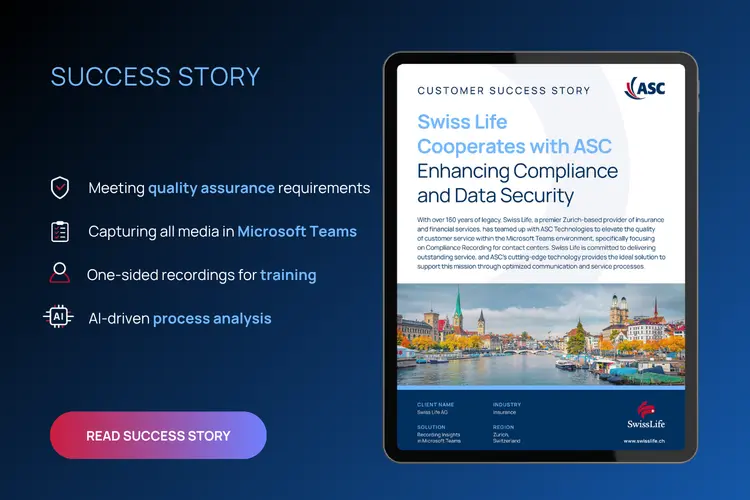Artificial Intelligence, Financial Services
AI Status Quo and Trends in Insurance

The insurance sector is undergoing rapid transformation, driven by big data and the use of artificial intelligence (AI). Key technologies such as AI agents and generative AI tools are transforming the insurance landscape, creating new opportunities in customer service, ai in claims, and insurance underwriting.
AI applications help insurance carriers and insurance providers make better use of data, identify patterns, and support faster underwriting processes. They also help insurers deliver personalized customer experiences, streamline operations through automation, and generate more precise risk analyses. The impact of AI in insurance is clear: improved efficiency, higher customer satisfaction, and the foundation for long-term growth.
Studies show that 68% of insurers worldwide are already using AI. The studies confirm that the biggest drivers for companies are efficiency gains and improved customer satisfaction (PwC 2024/25). In Germany and Austria, claims reporting (59%) and contract analysis (41%) are among the most important use cases (Wavestone 2023).
The transformation of the insurance industry is driven by deep learning and the implementation of new technologies. Companies that are now seamlessly integrating AI into their processes are not only equipping themselves technologically for the challenges of the insurance market but also creating the opportunity to build long-term customer loyalty through the successful use of AI-supported solutions – the basis for scaling revenue and growth.
Despite the opportunities, skills shortages, data protection, and AI governance pose challenges. Insurers who use AI strategically and sustainably secure competitive advantages through more efficient processes and innovative offerings.
Greater Efficiency: Case Management and Claims Processing With AI
The use of new technologies opens up enormous potential for insurers, especially in incident handling and claims processing: The benefits of AI include less manual work, greater transparency, and consistent processes. The key lies in content understanding.
Valuable information is extracted from unstructured customer communication – such as phone calls, chats, or emails – transformed into uniform formats, and significantly improving data quality. By implementing AI, insurers create the foundation for end-to-end process optimization and seamless automation.
Case Processing With AI: Use Cases for Optimized Services
An insurance advisor speaks with a customer who wants to take out a new insurance policy. During the conversation, details are shared that are hard to remember and time-consuming to capture manually: name, address, selected options, and contract duration. Intelligent AI tools such as Recording Insights transcribe and analyze the conversation in real-time, capturing this information from customer communication in structured form.
AI can be used to recognize the customer’s intent, extract the relevant data (“travel insurance” and “family bonus option”), and automatically create a new work item in the system. Instead of having to enter the information manually, the process is documented seamlessly, enabling further automation. Based on this, AI can help trigger workflows, such as automatically sending the policy or forwarding contract details to the insurance partner.
With AgenticAI and assistants such as Microsoft Copilot, insurers can leverage AI to extend these workflows – from data capture to seamless transfer into software platforms like Dynamics 365.
Smart Claim Handling for Insurers
The same principle can be applied to claims settlement. When a policyholder reports a claim by phone, the AI analyzes the description to understand the course of the incident. During the conversation, the software can identify the type of claim in real time. This allows the AI to support the agent with next best actions during the conversation by displaying a list of information or documents that are still needed and asking for the missing details. The workflow is documented seamlessly, and the next steps in the process (e.g., commissioning an expert or settling the claim) can be triggered by AI.
The entire workflow is documented seamlessly, and the next process steps – such as assigning an expert or initiating settlement – can be triggered through automation. Insurance providers benefit from faster processing, greater transparency, and reduced manual effort. For customers, the use of AI means quicker response times and therefore shorter claims cycle times. By applying AI across the value chain, from intake to settlement, insurers not only speed up decision-making but also improve the quality of insurance products. Moreover, AI reduces operational costs and supports ai in underwriting by linking claims data with policy and risk assessment. These improvements contribute directly to higher customer satisfaction and loyalty.
Dashboards also provide real-time reports on case volumes, processing times, and bottlenecks – an important basis for resource planning.
- For managers, a central overview of all cases allows them to monitor the processing status and distribution of topics in order to optimize business processes.
- Employees also receive a personal queue ("MyQueue") from an AI assistant, which summarizes all cases assigned to them so that they can concentrate efficiently on their tasks.
- Faster case processing and improved customer experiences for customers.
Fraud Detection and Risk Analysis with AI Applications

Fraud detection, risk management, and risk assessment remain top priorities for insurance providers. Wherever insurance claims are settled, there is always the risk of abuse. Fraud costs the insurance industry billions each year through staged accidents, manipulated invoices, or multiple claims. Traditional verification methods are often too slow and too manual to reliably detect fraud attempts.
Specialized AI solutions are capable of analyzing huge amounts of data – from claims reports and transcripts to historical policy data – in real time. AI and machine learning help identify complex patterns through the use of machine learning, unusual behavior, or inconsistencies through natural language processing in text, which would be more difficult for human analysts to detect.
- Anomaly detection: Machine learning models can recognize patterns, compare current claims reports with historical data, and identify deviations that indicate fraud.
- Network analysis: AI links data points and uncovers hidden relationships between cases – such as identical addresses, recurring phone numbers, or bank accounts.
- Real-time assessment: Suspicious cases are flagged immediately so that review teams can take targeted action.
Read more about Fraud Detection with AI in our blog article.
Smart Support for Sales and Advisors for Greater Customer Satisfaction
In an increasingly competitive industry such as the insurance sector, personal customer relationships are the most important success factor. Instead of burdening sales staff with manual and administrative tasks, AI supports advisors as intelligent copilots. This gives advisors time to focus on what is most important: identifying customer needs and increasing sales for long-term business success. This is achieved primarily through personalized advice and a stronger customer focus. By using AI, advisors can be supported by AI throughout the entire customer journey: from initial contact to contract conclusion.
Lead qualification: AI evaluates incoming inquiries based on data such as age, contract portfolio, or search behavior. This allows advisors to immediately identify which contacts are particularly promising.
Next best action: Based on historical customer data and behavior patterns, AI automatically suggests the next logical step—be it a consultation, an additional offer, or a contract extension.
Cross-selling and upselling: Through pattern recognition, AI identifies additional needs, such as home contents insurance following home insurance, and can thus provide tailor-made offers.
For insurance companies, this means:
- Efficiency in sales, because routine tasks are automated.
- Greater sales potential, as additional offers are placed in a targeted manner.
- Higher customer satisfaction because inquiries are answered more quickly and accurately.
The use of AI also brings regulatory advantages: AI-supported consultations can be fully documented and provided with audit trails – a plus for compliance and evidence management.
In a highly regulated industry such as insurance, innovation must never be considered in isolation from the legal framework. With every automated recommendation and every data-driven decision, questions of regulation, transparency, and compliance come to the fore.
AI in Line With Regulatory Requirements and Compliance
With every new application of artificial intelligence in the insurance industry, the responsibility to comply with regulatory requirements also grows. After all, innovation must not come at the expense of transparency, traceability, or data protection. Insurers operate in a complex regulatory environment that is constantly evolving.
AI models are subject to strict regulatory requirements designed to ensure both the protection of personal data and compliance with ethical and legal guidelines. Relevant regulations such as the European General Data Protection Regulation (GDPR), the EU AI Act, and industry-specific standards such as the Financial Investment Brokerage Regulation (FinVermV) and the Insurance Supervisory Requirements for IT (VAIT) define clear requirements for the transparency, traceability, and controllability of AI systems.
Insurers must ensure that AI-based decisions are traceable and documented to enable audit-proof documentation. insurers must ensure that automated processes do not lead to discrimination or disadvantage and that personal data is only processed to the extent permitted. This requires the use of specialized governance frameworks, continuous risk analysis, and close cooperation between compliance, IT, and specialist departments.
Insurers who use AI successfully view technology as a strategic transformation project. They invest not only in systems, but also in data quality, governance, and change management.
Best practices for the use of AI:
- A clear data strategy as the basis for all models.
- Continuous monitoring and readjustment of algorithms.
- Transparent communication with customers about automated decisions.
- Human oversight in all critical processes.
Success Story: Swiss Life Relies on Recording Insights
Swiss Life Group, one of Europe’s leading insurance providers, uses Recording Insights to ensure compliance, transparency, and efficiency across all customer communications. Integrated natively into Microsoft Teams, the solution records and analyzes conversations in real-time – providing secure documentation, faster auditing, and a consistent customer experience across departments.
By leveraging AI-powered compliance, Swiss Life automatically classifies calls, detects relevant topics, and streamlines case management and claims processing. This allows the company to reduce manual effort, improve collaboration, and maintain full compliance with state insurance regulations and internal policies.
The project highlights how AI solutions such as Recording Insights enable established insurance companies to combine compliance and innovation – turning everyday communication into actionable insight and measurable business value.




